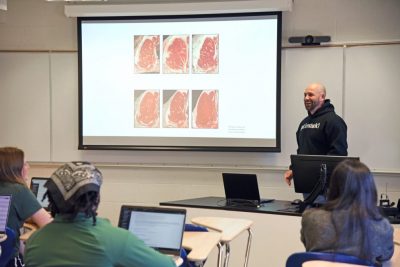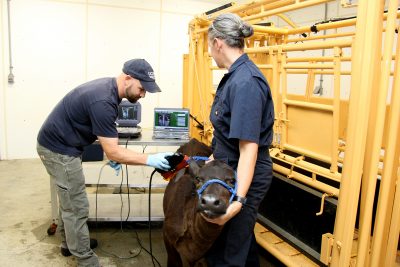NE SARE Grant Comparison Chart
February 3, 2025
February 3, 2025
April 21, 2023

Connecticut may be best known as leaders in manufacturing and insurance, but one longstanding UConn program aims to help beef up the state’s meat industry.
The meat science program in UConn’s College of Agriculture, Health and Natural Resources teaches students about Connecticut’s unique industry profile while providing them with the skills to work anywhere. Established in the 1950s, the program continues to evolve to meet student and business needs.
Connecticut’s Unique Industry
Just like the state itself, the meat industry in Connecticut has an obvious difference from competitors in other parts of the country: size. Most Connecticut producers operate at a much smaller scale than in the Midwest, which has considerably more open land and less population density.
These different agricultural profiles have to do with history, geography, and corn, explains Joe Emenheiser, UConn Extension educator and animal science instructor.
“A lot of this is predicated on cheap food policy, and the cost of production and processing is cheaper where more land is available. All the costs between the animal level and the consumer level, they all matter,” Emenheiser says.
Historically, the meat industry developed first on the East Coast, often near cities. But as people moved westward, there was more space for raising livestock at a lower price. Plus, new transportation systems allowed food products to be shipped from the Midwest back East. Another big advantage the Midwest had over East Coast states like Connecticut is that it is much easier to grow corn, an important food source for livestock….
Read the rest of the article here
March 9, 2023

Work continues on our Beef x Dairy crossbreeding project, which is a 3-year collaboration between UConn and Penn State, funded by a Northeast SARE grant. The last calf has been born on campus, and the first two groups of cattle are harvested. 30 of 40 left to go! We continue to compile and analyze all the growth and meat quality data, and I will bring that to you via extension programming as soon as the project is complete. Meanwhile, we also conducted a large regional survey of beef x dairy practices for the Northeast. A manuscript of those survey results was submitted for peer-reviewed publication in Translational Animal Science in January. Again, as soon as the data are published, they will be made available to you! We’re already making national news – check out Progressive Cattle magazine from September 2022 for a neat feature article on my use of ultrasound technology for the beef x dairy project.
I continue to partner with UConn Extension colleagues on the Tri-State SARE, Solid Ground, and 4-H teams, as well as the newly formed Farm Viability team…
-Joe Emenheiser, PhD
January 31, 2023
October 7, 2022
ATTN
Highly pathogenic avian influenza (HPAI) was detected in a backyard flock in New Haven County on October 4, 2022. Please click here for the full press release and links to resources from the CT Dept of Ag
September 5, 2022
Limitations associated with characterizing and quantifying sheep operations in the state of Connecticut present obstacles to communication, community development, and growth opportunities for producers. A survey was conducted from October 2021 to February 2022 in order to gain insight into the status and health of the Connecticut sheep industry and to identify areas of profitability in the state. The survey was distributed virtually and at the annual Connecticut Sheep Breeders Association meeting in December 2021. Sixty-six viable responses were collected and analyzed. The results of this survey will be used by the University of Connecticut and the Connecticut Sheep Breeders Association to establish baselines with regard to producers and sheep and will be valuable in designing and implementing timely programming and resources for Connecticut sheep producers.
Sara Tomis and (Dr.) Amy Safran, Department of Animal Science, UConn
(Dr.) Joe Emenheiser, Department of Extension, UConn
CT Sheep Survey Report Factsheet August 2022
 Loading...
Loading...
August 25, 2022
Nitrate accumulates in soils during times of drought due to microbial action. Microbes create the nitrate as normal byproducts of their metabolism. In soils with normal moisture levels the nitrate dissolves into the water and moves at relatively low levels in to the plants to be used to create protein. In dry soils the nitrate can’t move into the plant roots so it accumulates in the soil. When the rain finally falls this accumulated nitrate all dissolves into the dater at once. The plants need time to recover so the nitrate Nitrate moving into plants stressed by drought moves upward into the plants slowly. This recover process can take 3-5 days in grass species including corn). Since the nitrates are higher in lower portions of the plant if you are going to harvest immediately for feed raise your cutting height. This is especially important with corn silage if you intend to green chop to feed while harvesting corn. Nitrates in silage reduce 50 to 60 % in silage but it can take 3-4 weeks for levels to drop. For extremely browned out grass species – like a lot of hay fields, pastures and lawns this summer the brown stalks will not take up the moisture – they are dead and the capillaries needed to move liquid up the plant have broken and will no longer function. This means that the forage that springs out of the stems at the soil surface – all the “new growth” bright green grass will be what contains the high nitrate levels. For pastured animals you should move animals off the recovering pastures and keep them confined into winter feeding areas and keep feeding them stored feed until the new grass has a chance to grow, reestablish and metabolize the extra nitrate into plant protein before the animals graze it again.
You can test for high levels by sending a sample to a forage testing lab. Nitrate N (NO3-N) levels <1,000 ppm on a dry matter basis are considered safe. Nitrate between 1,000 – 1,700 should be left to mature in the field or left to cure on a silage pad before feeding out. Nitrate levels > ~ 2,000 can be acutely toxic and potentially lethal to livestock. There will likely be a run on the labs since drought has been widespread throughout the Northeast region, so keeping the animals off pasture, or waiting to harvest for a week or so might be the best way to manage the situation.
For more in-depth information, here are a few links
https://extension.psu.edu/be-aware-of-the-risks-of-nitrate-accumulation-in-annual-forages-this-year
https://extension.psu.edu/what-to-do-with-droughty-corn-fields
March 29, 2022
Article by Joe Emenheiser, Ph.D.

Meat quality improvement can improve economic development for Connecticut livestock producers. Ultrasound technology can evaluate body composition traits in livestock. This means livestock producers can check meat qualities in live animals. It leads to better livestock selection and breeding decisions.
A three-year grant project on Beef x dairy crossbreeding is improving growth and carcass composition. Dairy farms are using more beef x dairy crossbreeding because of milk price volatility and decreased value of replacement dairy heifers. Beef prices and demand are also strong. Although beef x dairy crossbreeding is not new, we have not studied many aspects with modern genetics. Our team is looking at the effects and economics of different management practices.
We ultrasound UConn beef x dairy calves monthly. Then, we evaluate the effects of different nutrition protocols. This includes body composition development measurements, such as fat thickness, loin muscle size, and percentage intramuscular fat (marbling). Our team considers this information along with data on calf performance, carcass value, and cost of production. It informs Extension programming and recommendations for livestock producers. We also work with meat livestock producers to increase the use of ultrasound technology in on-farm decision making.
Northeast SARE funds Nutritional Management Strategies for Improving Growth and Carcass Composition of Beef-Dairy Crossbred Calves. Collaborators are Drs. Sarah Reed, Kristen Govoni, and Steve Zinn from the UConn Animal Science Department and Dr. Tara Felix from Penn State University.